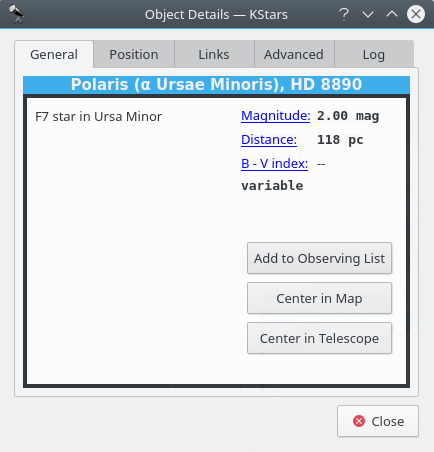Object Details Window¶

The Object Details Window presents advanced data available
about a specific object in the sky. To access this tool,
right-click on any object, and select the Details... item
from the popup menu.
The window is divided into a number of tabs. In the General
tab, we present basic data about the current object. This
includes names and catalog designations, object type, and
magnitude (brightness). On the
Position tab are the object’s Equatorial and Horizontal
coordinates, as well as its rise, set and transit times.
In the Links tab, you can manage the internet links
associated with this object. The Image and Information links
associated with the object are listed. These are the links
that appear in the popup menu when the object is
right-clicked. You can add custom links to the object with
the Add Link... button. This will open a window in which you
fill in the URL and link text for the new link (you can also
test the URL in the web browser from this window). Every
time you add a custom URL to a certain object, you are able
to choose the resource type using the Resource Type button.
Keep in mind that the custom link can easily point to a file
on your local disk, so you can use this feature to index
your personal astronomical images or observing logs.
You can also modify or remove any link using the Edit
Link... and Remove Link... buttons.
The Advanced tab (not available for all objects) allows you
to query professional astronomical databases on the internet
for information regarding the current object. To use these
databases, double click on the desired database in the list
to see the results of your query in a web browser window.
The query is made using the primary name of the object you
clicked on to open the Details Dialog. The following
databases are available for querying:
Set of Identifications, Measurements, and Bibliography for Astronomical Data (SIMBAD): SIMBAD is similar to NED, except it provides data about all kinds of objects, not just galaxies.
SkyView: Provides images from All-Sky surveys that have been performed in dozens of different parts of the spectrum, from Gamma Rays to the Radio. The KStars interface will retrieve an image from any of these surveys, centered on the selected object.
High Energy Astrophysical Archive (HEASARC): Here you can retrieve data about the current object from a number of “High-energy” observatories, which covers the Ultraviolet, X-ray and Gamma Ray portions of the electromagnetic spectrum.
NASA/IPAC Extragalactic Database (NED): NED provides encapsulated data and bibliographic links about extragalactic objects. You should only use NED if your target is extragalactic; i.e. if it is itself a galaxy.
NASA Astrophysical Data System (ADS): This incredible bibliographic database encompass the entire body of literature published in international peer-review Journals about astronomy and astrophysics. The database is divided into four general subject areas (Astronomy and Astrophysics, Astrophysics Preprints, Instrumentation, and Physics and Geophysics). Each of these has three sub-nodes that query the database in different ways. “Keyword search” will return articles which listed the object’s name as a keyword. “Title word search” will return articles which included the object name in their Title, and the “Title & Keyword search” uses both options together.
Multimission Archive at Space Telescope (MAST): The Space Telescope Science Institute provides access to the entire collection of images and spectra taken with the Hubble Space Telescope, as well as several other space-based observatories.
Finally, in the Log tab, you can type in some text that will
remain associated with this object’s Details window. You
could use this to attach personal observing notes, for
example. Your notes will be saved, such that you can easily
read or use them next time when you will use KStars.
